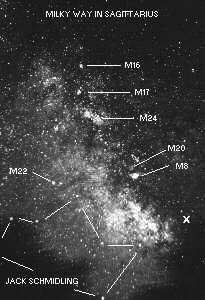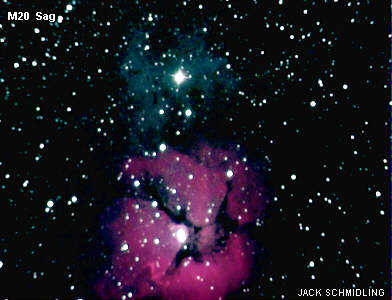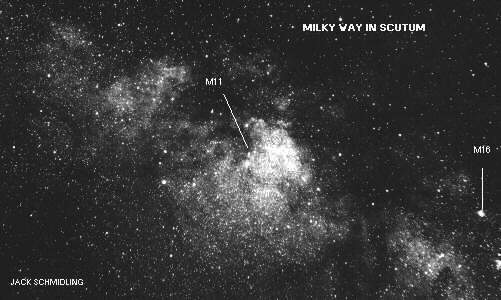MILKY WAY
Jack Schmidling Productions, Inc.18016 Church Road ~ Marengo IL 60152
| ASTRONOMY PAGE | HOME PAGE |
THE MILKY WAY
To earler civilizations, the Milky Way was such a large part of the nightime experience that it was considered by many to be the "pathway to heaven". To our culture, if it is known at all, it is only to the educated because they read about it or the lucky traveler who visits places that do not suffer from the pervasive light pollution that makes it totally invisible anywhere near metropolitan areas.
It is my opinion that anyone who has not seen the Milky Way in all its splendor has not lived a complete life. Seeing this awsome band of glitter, passing from the Southern horizon, almost to the Northern should be a vacation destination on everyone's list.

The Milky Way is a giant spiral galaxy like many others we have discussed on these pages. Like viewing a forest when amongst the trees, we can only imagine what the whole galaxy looks like and this imaginary image of a typical spiral is as good as any.
The Sun is just one of about 200 billion stars that make up our galaxy and it orbits the center about every 200 millions years. That would be one "cosmic year" which provides a great way to seem young again. The Sun is in one of the spiral arms about midway between the center and the edge of the galaxy.
When we see the Milky Way in the sky, it is because we are looking toward the center where vast numbers of stars are in our line of sight. When we look elsewhere, all we see are the stars randomly scattered above and below the plane of the galaxy.

Southern Milky Way
A good place to start exploring the Milky Way is on the Southern horizon in mid-Summer. The brightest and most interesting part is in and around the constellation Sagittarius. Although this group of stars is supposed to represent the Archer, most people find the "Teapot" easier to identify.
The spout of the Teapot points to the actual center or hub of the galaxy which I have marked with an "X". It happens to be blocked by trees in this photo as I have a limited view of the Southern Horizon and can only photograph small sections as they pass through the notch in the trees.
There are many interesting objects in this photo alone that we will expand upon in future weeks and we will add more large scale views as we move across the Milky Way.
This aswome sight is at it's peak right now and if you can find any way to get out to a dark place to see it, you will never forget it.

The Lagoon Nebula
This week we highlight one of the most interesting objects in the Southern Milky way, the star cluster and nebula known as the Lagoon Nebula.
It's catalog designation M8 points to its location in the photo of last week.
The first thing to note about the "Lagoon" Nebula is that the person who named it seemed to have a confused idea of what a lagoon is. The dark band through the middle more closely resembles a channel, whereas a lagoon is a small body of water surrounded by a ring of coral.

The Lagoon Nebula
The most conspicuous feature of this nebula in photos is the vast cloud of hydrogen gas illuminated by the hot stars within.
Less conspicuous but even more interesting are the roundish black "globules" that are thought to be stars in the making. These are vast clouds of dust and gas several times larger than the Solar System that are contracting into "proto-stars".
For more info on these "Bok Globules" see... Rosette Nebula








